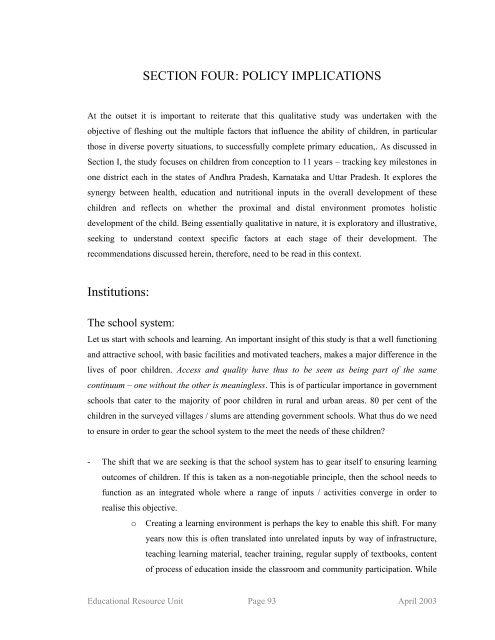Snakes and Ladders - ERU Consultants Pvt. Ltd.
Snakes and Ladders - ERU Consultants Pvt. Ltd.
Snakes and Ladders - ERU Consultants Pvt. Ltd.
Create successful ePaper yourself
Turn your PDF publications into a flip-book with our unique Google optimized e-Paper software.
SECTION FOUR: POLICY IMPLICATIONS<br />
At the outset it is important to reiterate that this qualitative study was undertaken with the<br />
objective of fleshing out the multiple factors that influence the ability of children, in particular<br />
those in diverse poverty situations, to successfully complete primary education,. As discussed in<br />
Section I, the study focuses on children from conception to 11 years – tracking key milestones in<br />
one district each in the states of Andhra Pradesh, Karnataka <strong>and</strong> Uttar Pradesh. It explores the<br />
synergy between health, education <strong>and</strong> nutritional inputs in the overall development of these<br />
children <strong>and</strong> reflects on whether the proximal <strong>and</strong> distal environment promotes holistic<br />
development of the child. Being essentially qualitative in nature, it is exploratory <strong>and</strong> illustrative,<br />
seeking to underst<strong>and</strong> context specific factors at each stage of their development. The<br />
recommendations discussed herein, therefore, need to be read in this context.<br />
Institutions:<br />
The school system:<br />
Let us start with schools <strong>and</strong> learning. An important insight of this study is that a well functioning<br />
<strong>and</strong> attractive school, with basic facilities <strong>and</strong> motivated teachers, makes a major difference in the<br />
lives of poor children. Access <strong>and</strong> quality have thus to be seen as being part of the same<br />
continuum – one without the other is meaningless. This is of particular importance in government<br />
schools that cater to the majority of poor children in rural <strong>and</strong> urban areas. 80 per cent of the<br />
children in the surveyed villages / slums are attending government schools. What thus do we need<br />
to ensure in order to gear the school system to the meet the needs of these children?<br />
- The shift that we are seeking is that the school system has to gear itself to ensuring learning<br />
outcomes of children. If this is taken as a non-negotiable principle, then the school needs to<br />
function as an integrated whole where a range of inputs / activities converge in order to<br />
realise this objective.<br />
o Creating a learning environment is perhaps the key to enable this shift. For many<br />
years now this is often translated into unrelated inputs by way of infrastructure,<br />
teaching learning material, teacher training, regular supply of textbooks, content<br />
of process of education inside the classroom <strong>and</strong> community participation. While<br />
Educational Resource Unit Page 93 April 2003












